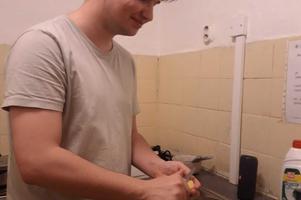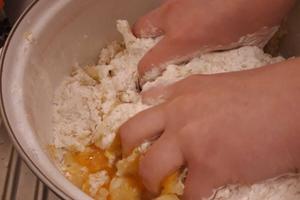Yehor Zhukov is struggling for space in the tiny, dingy university dormitory kitchen where he is trying to make Slovak traditional potato-based noodles šúľance.
The Ukrainian student says he is lucky though that he is not making any of his native dishes. Compared to Slovak cuisine, Ukrainian dishes are much more elaborate and difficult to prepare.
“Making Ukrainian meals in school dormitories is near-impossible,” the 21-year-old tells The Slovak Spectator.
Zhukov has decided to try and make šúľance more out of necessity than anything else. Thick noodles that can be boiled quickly and make a hearty lunch or dinner, he likes their simplicity.
“If I could, I’d prepare Ukrainian meals regularly, but they need time, space and care,” he says.
As he begins to peel the potatoes, he describes a similar Ukrainian food - zrazy (зрази) – which have the same potato base as šúľance but have minced meat or cabbage mixed into the dough before they are fried in a pan.
Few Ukrainian meals are as simple as zrazy, though.
Elaborate meals
Having peeled the potatoes, he puts them in a pan on top of a small electric stove, and, as he waits for them to come to the boil begins to explain the main characteristics of Ukrainian cuisine.
Much of it, he says, revolves around working with dough.
Often called ‘Europe’s breadbasket’, flour, and particularly dough, are a central part of many Ukrainian dishes, more so than the traditional meals of some of its neighbours, including Slovakia.
The potatoes are boiled now, and the student begins to prepare the dough. While a Ukrainian dish would typically call for any dough to be given time to rest, Zhukov takes the boiled potatoes and shreds them into a bowl, following a family recipe he has been given by a Slovak classmate.
Then he adds two eggs, flour, and a pinch of salt.
It is his first time preparing a traditional Slovak meal, but as he mixes the ingredients, his thoughts drift back to the dishes of his homeland.
“My all-time favourite meal is the soup borshch (борщ),” Zhukov, who is in his fourth year studying and living in Slovakia, says.
His eyes light up as he continues.
“People tend to think that borsch is Russian, which is not true,” he goes on, adding that borsch is on UNESCO’s Intangible Cultural Heritage List and is a Ukrainian national food.
Russians have their own soup, called shchi (щи), which is very different and nowhere near as delicious as Ukrainian borshch, he says.
The dough is now ready - heavy, as it should be – for cutting into the traditional šúľance shape. Zhukov prepares a cutting board and covers it in flour to stop the dough from sticking.
While a pot of slightly salted water comes to the boil, he takes the dough and cuts them into approximately equally-sized pieces and rolls each one out into a noodle – hence the name šúľance, from the verb šúľať meaning to roll.
Potato obsession
During his years in Slovakia, Zhukov has had a steady supply of food from home – ether brought by relatives on visits, or sweets, which he insists are far better than Slovak sweets, sent by his mother. He also sometimes goes to a Georgian-Ukrainian bistro, which he found not too long after he arrived in Slovakia, which serves many of his favourite Ukrainian meals.
But his day to day eating habits do not revolve exclusively around Ukrainian kitchen, he says as he rolls out the šúľance. He enjoys Slovak dishes, even if, he suggests, Slovaks have a mild obsession with potatoes in their cooking.
One of his dormitory roommates from the Orava region in northern Slovakia has a habit of cooking a meal made out of potatoes almost every day of the week.
“Everything from baked to mashed potatoes, he manages to use potatoes over and over again. It’s fascinating,” says Zhukov.
He knows that Slovak cuisine is not all just mashed potatoes, šúľance, and lokše, but still, Ukrainian cuisine feels more diverse, he says. He admits though, as he puts the šúľance in boiling water, that he does like a potato in his meal.
He lets them boil for five to seven minutes before straining the water and letting them rest in a bowl.
Usually, šúľance are served with butter and a sprinkling of sugar and poppy seeds on top. Other sweet alternatives are sugar and cocoa.
But Zhukov decides to give his a savoury twist, pairing them with sour cream and cheese.
All that is left now is to eat them.
Ingredients
Servings: 5 servings
1 kg of potatoes
700 grams of flour
2 eggs
Pinch of salt
Savoury or sweet topping to finish
Preparation
STEP 1
Peel and clean the potatoes. Put them in a pot filled with water, add a pinch of salt. Boil for about 20 minutes. The potatoes should not be over-boiled.
STEP 2
Shred boiled potatoes into a bowl. Add flour, salt and two eggs. Knead into a dough that holds its shape. Use flour for your hands to stop sticking.
STEP 3
Sprinkle flour on a rolling board. Take a piece of the prepared dough. Cut it into pieces, and roll dough into thick noodles - šúľance. Once ready, boil them in the water for about five to seven minutes. Drain the šúľance. Repeat until you run out of dough.
STEP 4
Let the šúľance rest and cool for a bit before serving. The meal can be served both savoury and sweet (with sugar and poppy seeds or sugar and cocoa are popular variations). Enjoy.



 Dough for šúľance. (source: M. J. for The Slovak Spectator)
Dough for šúľance. (source: M. J. for The Slovak Spectator)


